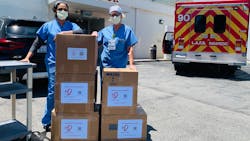Report analyzes the current state of PPE costs and the future
Data from PINC AI, a technology platform, show that over the course of the pandemic, hospitals nationwide spent more than $3B to source personal protective equipment (PPE) for worker and patient safety. However, since the high point of spending in the second quarter of 2020, PPE costs have steadily declined. The report was announced by Premier.
During a pre-pandemic baseline period (2Q-3Q 2019), hospitals typically spent a little over $7 per patient, per day on PPE, a figure that skyrocketed to $20.40 during the spring of 2020, driven by increased consumption, as well as off-contract buying and PPE bidding wars that occurred as health systems had to compete with federal and state governments and other providers to source limited supplies. Since that point in time, pricing has fallen to $12.45 per patient, per day – or about half of what was paid during the height of the pandemic.
In addition, PINC AI data show that for some PPE categories, such as eye protection, surgical gowns and face masks, pricing is very near pre-pandemic levels, while demand remains strong.
While costs are on the decline demand for and consumption of PPE remains strong given the delta variant caseload surges this summer and fall. For instance, providers are still using 1,300 percent more N95 respirators than they were at the pre-pandemic baseline. However, Premier members are better positioned than others in the market because of best-in-class contracting, sourcing innovations and technology-enabled purchased services solutions.
Premier’s S2S direct sourcing subsidiary can source supplies globally on a supplemental basis. On average, S2S has been able to avoid many pricing increases and/or reduce overall costs for commodity items by 10-15 percent – cutting about $40M in costs from across the participants. S2S can provide an extensive array of PPE items from its global network, including all the categories discussed in this analysis.
To create competitive domestic alternatives to overseas overreliance, Premier has worked with our members to make investments in and/or long-term purchasing commitments with U.S. manufacturers, including Prestige Ameritech for N95 respirators and face masks, DeRoyal Industries for surgical gowns, Honeywell for nitrile exam gloves and Exela Pharma Sciences for pharmaceuticals. Through these investments and long-term purchasing commitments, Premier members can diversify their supply sources at a price point competitive with overseas manufacturing– effectively avoiding price increases that foreign suppliers have forced others to accept during the pandemic. In addition, these suppliers have increased their production to protect Premier members from shortages that continue to plague the market.
To conduct the analysis, PINC AI compared PPE spending trends across quarters beginning from September 2019 through September of 2021, leveraging a database representing 30 percent of U.S. hospitals across all geographic regions and hospital types. PPE items included in the analysis included eye protection, surgical gowns, N95 respirators, face masks, exam gloves and swabs. Total costs were calculated by measuring quantities used per patient, per day, multiplied by the percent change in pricing for that quarter.
